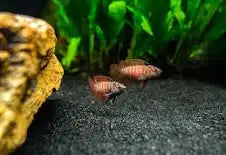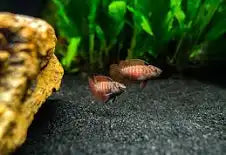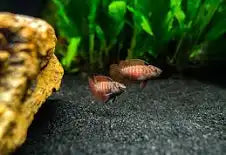Badis-Black Tiger
Badis-Black Tiger
check_circle Fast Shipping
check_circle Quality Products
check_circle Affordable Price
Reach out to us on ''available to order'' items via WhatsApp or email
Low stock: 4 left
Couldn't load pickup availability

Badis-Black Tiger
package_2
Product Description
Product Description
All our fish, shrimp and corals are bagged with fresh oxygen as well as a heat pack in winter.
When ordering livestock please select the box size and add it to your cart for accurate overnight (1-2 days) shipping costs. A small box can take 1-2 bags and a medium box 6 bags. One bag fits max 10 small (1-3cm) fish or max 2 medium (3-5cm) fish or max 1 large (>5cm) fish.
ONE SPECIES PER BAG. Eg: One bag of 10 neon tetra.
🐅 Black Tiger Badis Quick Stats
-
🐅 Black Tiger Badis Quick Stats
-
Scientific Name: Badis sp. “Black Tiger”
-
Common Names: Black Tiger Badis, BT Badis
-
Adult Size: 2 inches (5 cm)
-
Temperament: Semi-aggressive, territorial (especially males)
-
Lifespan: 3–5 years
-
Tank Size: 10+ gallons (20+ for groups)
-
Water Parameters:
-
Temperature: 72–79°F (22–26°C)
-
pH: 6.0–7.5
-
Hardness: Soft to moderately hard
-
-
Diet: Carnivore – live/frozen foods preferred
-
Difficulty: Moderate
⚫ Description
The Black Tiger Badis is a rare and striking dwarf predator known for its deep black coloration with contrasting tiger-like vertical stripes—especially prominent in dominant males. While similar in size and behavior to other Badis species, the Black Tiger is more vivid and often more secretive. Males show brighter colors and fin extensions, particularly when courting or displaying dominance.
🧼 Care Guide
-
Tank Setup: Provide lots of cover (plants, rocks, caves) as they prefer subdued lighting and hiding spots. Sand or dark substrate helps showcase their colors.
-
Behavior: Best kept singly or as a male-female pair. Multiple males will fight unless the tank is large and well-structured.
-
Feeding: Picky eaters—live/frozen foods like bloodworms, daphnia, or brine shrimp are preferred. They may ignore dry food entirely.
-
Water Quality: Stable, clean conditions are important. These fish do best in mature, well-cycled aquariums.
-
Breeding: Cave spawners; males guard eggs. Provide narrow caves or small tubes for breeding behavior.
-


